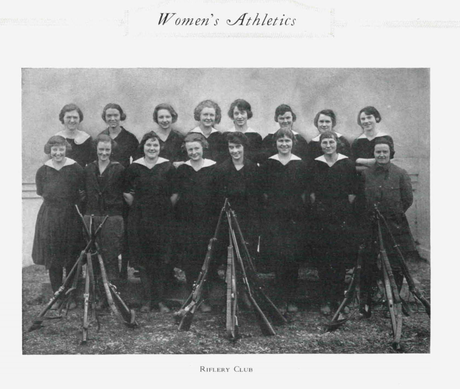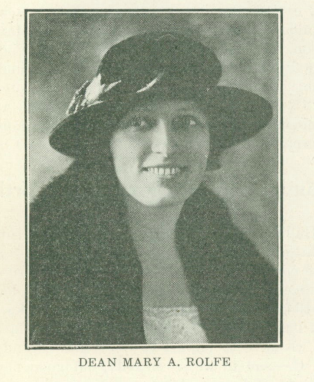Posted on by scarc
 Ava Helen Miller, fall 1921
Ava Helen Miller, fall 1921
[Part 1 of 2]
Ava Helen Miller entered Oregon Agricultural College (OAC), now known as Oregon State University, in the fall of 1921. She spent a total of five quarters at the school; one quarter shy of two full academic years. And even though her experience in Corvallis was relatively short, it was a memorable period for Ava Helen, one culminating in her meeting her future husband, Linus Pauling.
During the 1921-22 school year, OAC was home to its largest student body to date - more than 7,000 enrolled for at least one quarter, and a graduating class of 3,147. (2,040 men and 1,107 women.) The freshman class was 300 students larger than had been the case the previous year and the student body included 47 international students from Bolivia, Palestine, Peru and South Africa, among other far away lands. An additional 995 out of state students pursued an OAC education, with Washington leading the way (384) followed by California (315) and Idaho (111). Within the college, Home Economics awarded the most degrees that year, tallying 889; the School of Agriculture came in a close second with 876 degrees.
Those enrolled from out of state did so despite the fact that, in the fall of 1921, OAC began charging non-residents tuition - $20 per term - for the first time. The change impacted new students only, meaning that existing out of state students could still attend for free. (Ava Helen was a resident of Oregon, so this did not affect her.) Understanding the financial burden that this decision could have on its students, the OAC Board decided that non-Oregon residents who had served in World War I could receive a 50% discount on tuition. According to the monthly OAC Alumnus, the fees were enacted to "prevent an undue influx of students from other states and at the same time [provide] additional income [...] in the construction of buildings."

OAC's post-war population bump coincided with shifts in the types of activities available to the college's women students. Several clubs for women were sponsored, including those dedicated to riflery and mandolins, but new sports were an area where women were really able to broaden their horizons. OAC co-eds competed in baseball, basketball, swimming, track, tennis, archery, volleyball, and the afore-mentioned riflery; dance was also organized as part of women's athletics.
As was the case most everywhere however, traditional men's athletics remained far more popular across campus and the community. The most prominent sport at OAC was football and the team, affectionately known as the "gridiron squad," was lavished with rituals and processionals prior to each game. Among the most extravagant was a feeding party where the players dined on "big juicy steaks cooked rare, toast crisp through and through, big baked potatoes that rival the prizes of the Pullman diner [a popular upscale train car from the time] - all topped off with ice-cream." And though the men ruled the sporting world at OAC, these epic meals took place in the women's Home Economics Tea Room, as that was clearly the place for the best food on campus.
With more people at the school, more options to choose from, and requirements that first- and second-year women sign up for P.E. credits, its no surprise that, during Ava Helen's second year, women's physical education courses saw more enrollees than ever before. Elective options included seasonal sports, aesthetic dancing, swimming, or apparatus work, which is similar to gymnastics. The era's women did not play softball, but were allowed to play baseball (with other women). To help manage growing numbers, and to harken back to times when the program was much smaller, the Physical Education Club arranged weekly dinners to assist students in getting to know one another.
Competitive speaking was another area opening up to OAC's women. By the fall of 1921, women had three different debate teams available to them - varsity, junior varsity, and intramural. During Ava Helen's first year, the women's Dual Debate Team (junior varsity), competed against the University of California and was asked to address the possibility of Irish independence. Meanwhile, the varsity squad was charged with discussing: "That the principle of the closed shop should be applied to all American industries. Farming and all industries employing less than three men are excepted."
Intramural debate tended to pit classes against one another, with a 1921 contest asking freshmen and juniors to consider federal government ownership and operation of coal mines. Other topics shed light on the culture of the state a century ago - notably, a men's interclass competition considering whether or not "Oregon should enact a law prohibiting Orientals from acquiring land within the state."

By Ava Helen's time, women had clearly emerged as a priority for OAC. Importantly, in the fall of 1922, the college finished construction of its third women's dormitory, Margaret Snell Hall. And a year prior, OAC had welcomed it newest Dean of Women, Mary A. Rolfe.
Rolfe had worked for various organizations before OAC, including the YWCA and the University of Iowa, but immediately prior to her tenure in Corvallis she had served in France as a "searcher." In that role, she worked with other stenographers to write down wounded soldiers' last words, which would then be conveyed to their families back home. As Dean, Rolfe believed that "My relation to young women should be that of friend," an ideology that she upheld by creating opportunities for women and treating them as capable and inquisitive. One early example of this was her sponsoring the Oregon chapter of the Home Economics Conventions, a program "of interest to all women, whether professional home economics women, teachers, or homemakers."
Ava Helen Miller took advantage of all that her college had to offer during a period of significant change. An exploration of her experiences at OAC will be the focus of our post next week.
Filed under: Ava Helen Pauling, Pauling and Oregon | Tagged: Ava Helen Pauling, Oregon Agricultural College |
